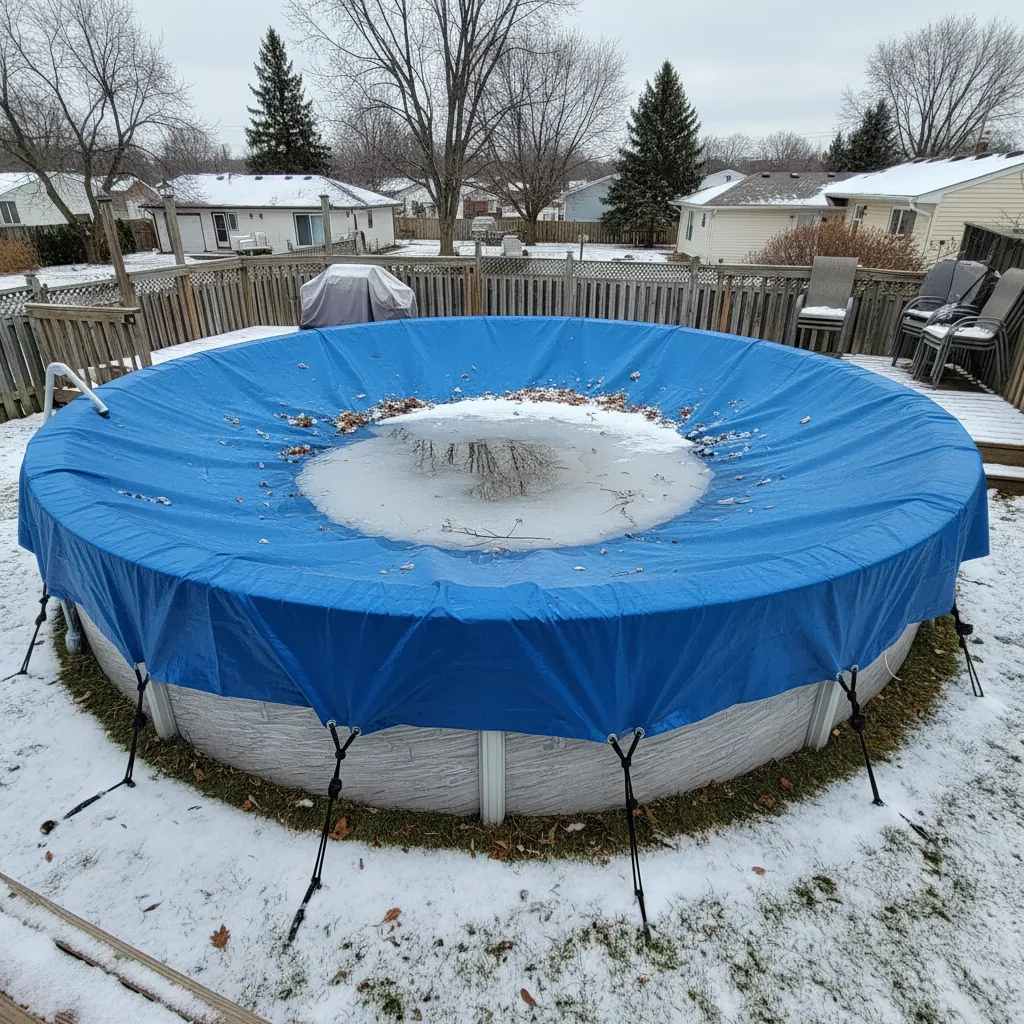Pool Sand Amount Calculator
Published on: April 28, 2025 | Last Updated: April 13, 2025
Written By: Lila Fairholme
Need to know how much sand your pool filter requires? This calculator helps determine the exact amount. Pool filters need specific sand quantities to work properly. The amount depends on your filter’s size and the sand type you use. We’ll help you calculate it in just a few simple steps.
Sand Calculator
How to Use
- Find your filter’s volume in the manufacturer manual
- Select your sand type from the dropdown
- Click calculate to get the exact amount needed
Note: Always round up to the nearest whole bag. Different sand brands might have varying density.
Crucial Winterizing Products
"The all-in-one solution for a guaranteed clear spring opening."
All-in-One Closing Chemical Kit
Winter demand is high - check stock
"The 'set & forget' option. This is the easiest winterizing I've ever done."
Simple 3-in-1 Winterizing Balls
Winter demand is high - check stock
"Invest once to protect your liner and prevent a swamp in the spring."
Heavy-Duty Winter Pool Cover
Winter demand is high - check stock
Factors Influencing Pool Filter Sand Requirements
Determining the correct sand quantity for your pool filter involves multiple variables. Each factor impacts filtration efficiency, equipment longevity, and water clarity. Let’s break down the key elements. Keeping an eye on these factors can also help you know when it’s time to change the sand in your filter. Regular checks can prevent problems and ensure your pool water stays clean and clear.
Filter Tank Size and Design
Sand filters come in diameters ranging from 16″ to 36″. Larger tanks require more sand to maintain optimal flow rates. For example:
- A 16″ filter typically holds 100-150 lbs of sand
- A 24″ model needs 300-400 lbs
- Commercial 36″ systems may use 1,200+ lbs
Tank shape also matters. Side-mounted laterals in vertical filters need precise sand depths (usually ⅔ full) to prevent channeling. Horizontal filters require uniform distribution to avoid dead zones. When considering pool maintenance, it’s important to use the right close above ground pool sand filter for your above ground pool. A close above ground pool sand filter can effectively manage water quality and clarity, ensuring a clean swimming environment.
Sand Media Type
Not all pool sands have identical density or particle size. The three primary types affect volume requirements:
| Media Type | Weight per Cubic Foot | Micron Rating | Typical Depth |
|---|---|---|---|
| #20 Silica Sand | 100 lbs | 45-55 microns | 16-18″ |
| Zeolite | 85 lbs | 5-10 microns | 20-22″ |
| Recycled Glass | 110 lbs | 15-25 microns | 14-16″ |
Zeolite’s lower density means you’ll need 10-15% more volume compared to silica. Glass media often requires compacting to prevent floatation in high-flow systems.
Flow Rate and Turnover Requirements
The pump’s gallons per hour (GPH) rating dictates minimum sand bed depth. Industry standards recommend:
- 15-20 GPM/sq.ft for residential pools
- 12-15 GPM/sq.ft for commercial pools
A 1.5 HP pump pushing 75 GPM needs at least 5 sq.ft of filter area. At 2″ Hg pressure, this requires 450 lbs of #20 sand to maintain 15 GPM/sq.ft flow.
Water Chemistry and Bather Load
High calcium hardness (>400 ppm) or frequent shock treatments degrade sand faster. Heavy usage (8+ swimmers daily) may require 5-10% extra sand to compensate for particle breakdown. Saltwater pools often need annual sand replacement versus 3-5 years in chlorine systems.
Sand Quantity Guidelines by Filter Model
Manufacturer specifications provide baseline numbers, but real-world conditions often demand adjustments. Below are common scenarios.
Residential Sand Filters
| Filter Model | Tank Diameter | Sand Capacity (lbs) | Max Flow Rate (GPM) |
|---|---|---|---|
| Hayward S166T | 16″ | 100 | 44 |
| Pentair TR-60 | 24″ | 325 | 62 |
| Waterway 580-3130 | 22″ | 250 | 75 |
Always check the lateral assembly height before filling. Sand should sit 6″ below the top of laterals to prevent media carryover.
Commercial Systems
High-rate filters like the Pentair Triton II TR-140 require 1,050 lbs of sand. Flow rates up to 225 GPM need 60″ bed depths. Multi-port valves on these units typically handle 50 PSI, necessitating tighter sand grading (0.45-0.55 mm uniformity coefficient). These specifications are important for pool owners looking to maintain clean and clear water. A sand filter suitable for a 10,000-gallon pool can efficiently manage debris and contaminants for optimal water quality.
Also See: Above Ground Pump Run Time: What You Need to Know

Sand Media Comparison and Performance
Choosing between silica, zeolite, or glass affects both quantity and maintenance cycles. Let’s analyze each option.
Silica Sand (#20 Grade)
- Pros: $12-$18 per 50 lb bag, widely available
- Cons: Needs replacement every 3-5 years
- Filtration: 20-40 microns
Zeolite
- Pros: Removes ammonia, lasts 5-7 years
- Cons: $25-$35 per 25 lb bag, higher head loss
- Filtration: 5-10 microns
Recycled Glass
- Pros: 7x surface area, 30% longer backwash intervals
- Cons: $40-$50 per 30 lb bag, possible UV degradation
- Filtration: 15-25 microns
Maintenance Factors Impacting Sand Volume
Initial calculations aren’t set in stone. Operational practices directly influence media longevity and replacement needs.
Backwashing Frequency
Each backwash cycle removes 2-3% of sand volume. Systems needing weekly backwashing lose 25-40 lbs annually. Install a pressure gauge to monitor when backwashing is truly needed—ideally at 8-10 PSI over clean pressure. Regular backwashing helps maintain the filtration system’s efficiency. A well-maintained backwash sand filter ensures clean water and extends the life of the equipment.
Channeling Prevention
Improperly leveled sand creates water channels, reducing effective filtration area. Use a carpenter’s level during filling. Tamp down media every 6″ to ensure density of 100-110 lbs/cu.ft. Proper leveling is important for the overall performance of your sand pool filter. A well-maintained sand filter can provide clear, clean water for a refreshing swimming experience.
Winterization Practices
Freeze-thaw cycles in cold climates expand sand particles. Northern pools often require 5% extra sand to account for winter breakdown. Use sand stabilizer additives if temperatures drop below 20°F. As winter approaches, it’s important to consider how cold temperatures can affect the entire pool. Cold weather can cause water in pools to freeze, which can lead to damage if not properly managed.
FAQs – Common Sand Quantity Questions
Can I Mix Different Sand Types?
Combining media (e.g., zeolite top layer over silica) voids most warranties. Different densities cause stratification during backwashing. Stick to one media type per filter. Choosing the right filter media is important for effective filtration. Pool filter media helps keep the water clean and safe for swimming.
How Does Pool Size Affect Sand Needs?
While pump HP and filter size matter more, larger pools (>30,000 gallons) benefit from 10% overfilling to handle heavier debris loads. Always match sand volume to filter specs, not pool gallons. Choosing the right filter is crucial for maintaining clean water. An all-purpose sand pool filter efficiently removes impurities, making it an excellent choice for many pool owners.
Why Does My Filter Require Annual Sand Replacement?
Frequent algae treatments or calcium scaling glazes sand particles. Test water hardness monthly. Maintain 200-400 ppm calcium hardness and 7.2-7.8 pH to extend media life.

Special Considerations for Unique Setups
Saltwater Pools
Chlorine generators produce finer particulates. Use 10% more sand or switch to 25 lb/ft³ density glass media. Check sacrificial anodes yearly—corrosion from salt can lower lateral height, requiring sand removal. Proper sanitation is crucial for pool maintenance. Chlorine helps keep the water free of harmful bacteria while the sand filter removes debris.
High Debris Environments
Pools near trees or in dusty areas need dual-layer systems. A 1″ gravel underbed with #8 grade stone improves drainage, allowing 15% less sand while maintaining flow rates.
Variable Speed Pumps
Low RPM settings (1,750 or below) risk sand bed compaction. For pumps running under 40 GPM, reduce sand depth by 2″ and increase backwash frequency by 20%.
Optimizing Your Sand Filter Performance
Proper sand management extends filter runs and saves money. Implement these pro techniques:
- Annual deep cleaning: Use a garden hose with pistol nozzle to agitate and flush trapped oils
- Pressure monitoring: Replace sand when clean pressure exceeds 50% of initial reading
- Media testing: Perform a clumping test—submerged sand should crumble easily when squeezed
For precise calculations tailored to your equipment and conditions, visit My Pool Calculator. Our tools account for regional weather patterns, specific pump models, and unusual pool shapes.
Cost Considerations and Budgeting
Sand prices fluctuate based on silica content and packaging. Here’s a regional price comparison for #20 grade:
| Region | 50 lb Bag Cost | Bulk (1,000 lbs) Discount |
|---|---|---|
| Northeast | $16-$22 | 12% |
| Southwest | $12-$18 | 15% |
| Midwest | $14-$20 | 10% |
Factor in disposal costs—local landfills charge $25-$50 per cubic yard for used sand. Some municipalities allow filter sand in construction fill—check regulations first.
Troubleshooting Common Sand Issues
Even properly calculated sand amounts can develop problems. Diagnose these frequent complaints:
Sand in Pool
Broken laterals or overfilled filters cause media discharge. Inspect laterals with a ⅛” drill bit—if it fits between slats, replace the assembly. Ideal sand level is 6″ below lateral tops.
High Pressure Readings
Compact sand from low flow rates increases PSI. Break up beds annually using a shop vac with reverse airflow. For persistent issues, add 1 lb of filter aid per 50 lbs sand.
Short Filter Cycles
Oversized pumps relative to sand volume cause rapid clogging. Verify your GPM matches the filter’s design rate. Install a flow meter if necessary—ideal velocity is 15-20 GPM/sq.ft. The right pump and filter system is crucial for maintaining clear water. A sand filter pool pump works efficiently by using sand to trap dirt and debris, ensuring a clean swimming environment.
Always cross-reference your calculations with the manufacturer’s manual. When in doubt, consult My Pool Calculator for scenario-specific guidance. Proper sand management keeps pools sparkling while minimizing operational costs.
Useful References for You:
- American National Standards Institute (ANSI). (2020). ANSI/PHTA Standards for Residential Swimming Pools. New York, NY: ANSI.
- Masonry Sand Volume Chart for Above Ground Pool Installations
- Sand Calculator – JURASSIC SANDS
- How Much Sand Do I Need for My Pool? | Angi
- Sand Calculator – Find How Much Sand You Need – Inch Calculator





